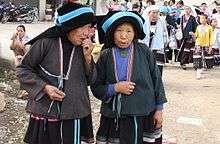Gelao people
 | |
| Total population | |
|---|---|
| 550,000 (est.) | |
| Regions with significant populations | |
|
China: Guizhou, Guangxi, Yunnan, Sichuan | |
| Languages | |
| Gelao | |
| Religion | |
| Taoism, Buddhism |
The Gelao people (also spelled Gelo) (own name: Klau, Chinese: 仡佬族; pinyin: Gēlǎozú) are an ethnic group of China and Vietnam. They form one of the 56 ethnic groups officially recognized by the People's Republic of China. However, many Gelao are also variously classified as Yi, Miao, and Zhuang by the Chinese government.
They number approximately 438,200 and are mainly located in the western part of the Guizhou Province, including such places as Liupanshui, Anshun, Dafang, and Bijie. Some live in western Guangxi, southeastern Yunnan, and southern Sichuan. The main religion practiced is Taoism with a small but significant Buddhist minority.
History
The Gelao people are often considered to be the aboriginal inhabitants of Guizhou. The ancestors of the Gelao were the Liáo (僚), who made up the population of the ancient Yelang (夜郎) kingdom.
Language
The Gelao language belongs to the Kadai language family. Today, only a small minority of the Gelaos still speak this language. Since the various Gelao dialects differ greatly from each other, Mandarin has been used as a lingua franca and is now the main language spoken by Gelaos. The Miao, Yi and Buyei languages are also used.
Culture
The traditional suits of the men consist of jacket done up to a side and long pants. The women wear short jackets and narrow skirts divided into three parts: the head office is elaborate in red wool while the other two are of fabric bordered in black and white colors. Men and women wear long scarves.
In their traditional music, the Gelao use a two-stringed fiddle with a body made from a cow horn, called the jiaohu (角胡; pinyin: jiǎohú).
Subgroups
The Gelao consist of various subgroups. Their historical exonyms, given in a provincial ethnic gazetteer from the Republic of China era, include the following.[2]
- Flowery Gelao 花仡佬, in Qianwei 前卫, Pingfa 平伐司, Yongning 永宁州, Shibing 施秉, Longquan 龙泉, Huangping 黄平
- Red Gelao 红仡佬, in Qingshan 青山司, Anping 安平县, Renhuai 仁怀县, Liping 黎平府
- Jiantou Gelao 剪头仡佬, in Guiding 贵定, Shibing 施秉, Huangping 黄平, Yongning 永宁
- Tooth-Hitting Gelao 打牙仡佬, in Pingyue 平越, Qianxi 黔西, Anping 安平, Yongping 永宁, Pingyuan 平远, Huangping 黄平, Qingzhen 清镇
- Guowo Gelao 锅圈仡佬, in Pingyuan 平远, Anping 安平, Dading 大定
- Datie Gelao 打铁仡佬, in Pingyuan 平远州
- Pipao Gelao 披袍仡佬, in Pingyuan 平远, Anping 安平, Dading 大定
- Shui Gelao 水仡佬, in Yuqing 余庆, Zhenyuan 镇远, Shibing 施秉, Yongning 永宁
- Tu Gelao 土仡佬, in Weining 威宁
- Yayi Gelao 雅意仡佬, in Yongning 永宁
Yiren
The Yiren (羿人), who number no more 3,000 people, live in the Chishui (赤水) area in Xuyong County, Sichuan, which is on the border with Guizhou.[3] They are a subgroup of the Gelao but have a distinctive history. The Yiren call themselves the gau13.[4] In comparison, the Gelao of Xinzhai 新寨, Puding 普定, Guizhou, call themselves the qau13. The Yiren live in:[4]
- Chishui village 赤水镇, Xuyong County 叙永县, Sichuan
- Napangou 纳盘沟, Gulin County 古蔺县, Sichuan. According to the Gulin County Almanac (1993), ethnic Gelao and Yiren are found on the northern banks of the Chishui River 赤水河, in Napan township 纳盘乡.
- Xiaohe 小河, Puyi 普宜, Bijie County 毕节县, Guizhou
- Yindi 阴底, Bijie County 毕节县, Guizhou
The Yiren have been mentioned since the Tang Dynasty, and were said to have come from the north. The Yiren are also noted for their belief in the Zitong (子童) Bodhisattva (菩萨).[4]
Unlike most Gelao dialects, the Yiren dialect uses a Loloish-derived numeral system (Zhang 1993:424).[4]
See also
References
- ↑ "The 2009 Vietnam Population and Housing Census: Completed Results". General Statistics Office of Vietnam: Central Population and Housing Census Steering Committee. June 2010. p. 134. Archived from the original on October 18, 2013. Retrieved 26 November 2013.
- ↑ Guizhou County Gazetteer: Ethnic Gazetteer [贵州省志. 民族志] (2002). Guiyang: Guizhou Ethnic Publishing House [貴州民族出版社].
- ↑ http://baike.baidu.com/view/2096335.htm
- 1 2 3 4 张済民/Zhang, Jimin. 仡佬语研究/Gelao yu yan jiu (A Study of Gelao). 贵阳市/Guiyang, China: 贵州民族出版社/Guizhou min zu chu ban she, 1993.
- Hoàng Thị Cáp. 2013. Văn hóa dân gian của người Cơ Lao Dỏ. Hanoi: Nhà xuất bản văn hóa thông tin. ISBN 978-604-50-0400-5